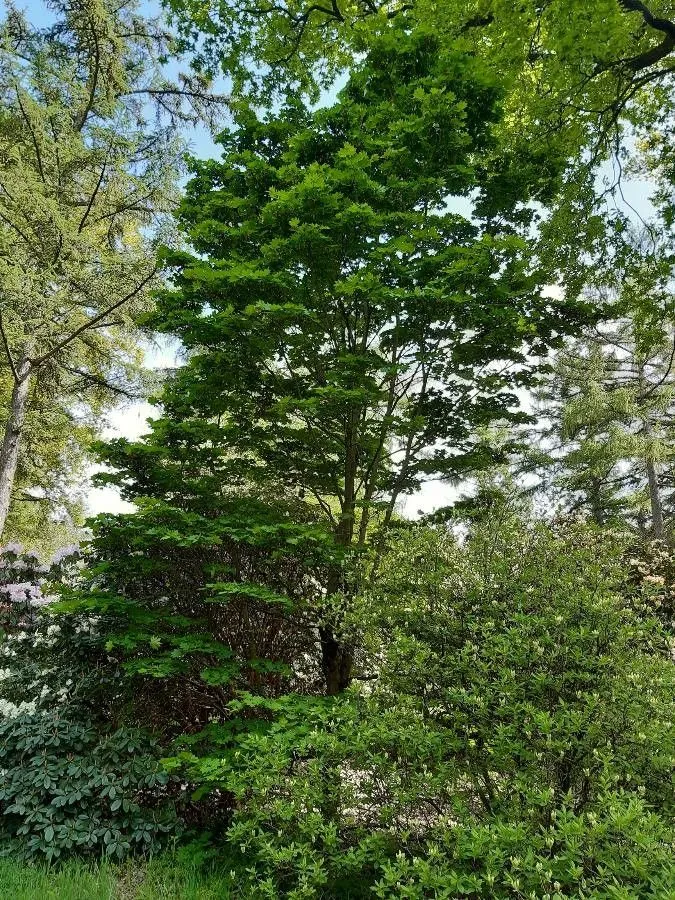
Author: (Pax) Kom.
Bibliography: Trudy Imp. S.-Peterburgsk. Bot. Sada 22: 725 (1903)
Year: 1903
Status: accepted
Rank: species
Genus: Acer
Vegetable: False
Observations: S. Russian Far East to Korea
The Korean maple, known scientifically as Acer pseudosieboldianum, is a captivating deciduous tree that belongs to the Sapindaceae family. Introduced in the early 20th century, with its species first described in the Trudy Imp. S.-Peterburgsk. Bot. Sada journal in 1903 by (Pax) Kom., this enchanting tree is native to the regions spanning from the southern Russian Far East to Korea.
Characterized by its elegant, lobed leaves that closely resemble those of the Japanese maple, the Korean maple is celebrated for its striking seasonal transitions. In the spring, the tree’s foliage emerges with shades of purple and green, offering a refreshing visual treat. As summer progresses, the leaves transform into a vibrant, lush green, providing ample shade and a serene atmosphere. However, it is in the autumn that the Korean maple truly shines, as its leaves morph into a fiery array of reds, oranges, and yellows, creating a breathtaking spectacle that rivals the best of autumnal displays in temperate climates.
The Korean maple typically grows to a moderate height, reaching up to 15 meters (about 50 feet) under optimal conditions. Its relatively compact size and graceful form make it a popular choice for both private gardens and public landscapes. Moreover, this species is known for its hardiness, capable of withstanding cold temperatures that would challenge many other maples, making it a resilient addition to various environmental conditions.
Not only is the Korean maple prized for its aesthetic appeal, but it also contributes ecological benefits. The dense canopy provides habitat and food for various bird species and insects, fostering biodiversity. Furthermore, the tree’s root system aids in soil stabilization, helping to prevent erosion in its native and introduced sites.
In cultivation, the Korean maple prefers well-drained soil with a slightly acidic to neutral pH and thrives best in regions that experience distinct seasonal changes. It can be grown successfully in both full sun to partial shade, though young trees should be protected from intense afternoon sunlight and strong winds. Regular watering during dry periods and mulching to retain soil moisture can enhance the tree’s growth and vigor.
Whether planted as a solitary specimen, part of a mixed border, or as an ornamental feature in landscaped parks, the Korean maple offers year-round beauty and resilience. Its adaptability and stunning seasonal displays ensure that it will remain a cherished component of botanical collections and natural landscapes for generations to come.
References:
– Trudy Imp. S.-Peterburgsk. Bot. Sada 22: 725 (1903)
Eng: korean maple
Nno: korealønn
Nob: korealønn
Zho: 紫花枫 (zi hua feng)
En: Korean maple, Keijo Maple
Zh: 假色槭, 紫花枫 (Zi Hua Feng)
Fi: Koreanvaahtera
Fr: Érable de Corée
De: Koreanischer Fächer-Ahorn
Is: Kóreuhlynur
Ko: 당단풍나무
Lv: Neīstā Zīdbolda kļava
No: Korealønn
Nb: Korealønn
Nn: Korealønn
Pl: Klon ussuryjski
Ru: Клён ложнозибольдов
Zh-tw: 假色槭
Taken May 13, 2021 by Philippe de Spoelberch (cc-by-sa)
Taken Sep 20, 2017 by Tela Botanica − Alain Bigou (cc-by-sa)
Taken Sep 20, 2017 by Tela Botanica − Alain Bigou (cc-by-sa)
Taken Jul 29, 2022 by Jennifer Ondrejka (cc-by-sa)
Taken May 21, 2021 by Даша S (cc-by-sa)
Taken May 13, 2021 by Philippe de Spoelberch (cc-by-sa)
Taken May 13, 2021 by Philippe de Spoelberch (cc-by-sa)
Taken May 13, 2021 by Philippe de Spoelberch (cc-by-sa)
Taken Sep 20, 2017 by Tela Botanica − Alain Bigou (cc-by-sa)
Family: Myrtaceae Author: (F.Muell.) K.D.Hill & L.A.S.Johnson Bibliography: Telopea 6: 402 (1995) Year: 1995 Status:…
Family: Rubiaceae Author: Pierre ex A.Froehner Bibliography: Notizbl. Bot. Gart. Berlin-Dahlem 1: 237 (1897) Year:…
Family: Sapindaceae Author: Koidz. Bibliography: J. Coll. Sci. Imp. Univ. Tokyo 32(1): 38 (1911) Year:…
Family: Asteraceae Author: A.Gray Bibliography: Pacif. Railr. Rep.: 107 (1857) Year: 1857 Status: accepted Rank:…
Family: Fabaceae Author: Medik. Bibliography: Vorles. Churpfälz. Phys.-Ökon. Ges. 2: 398 (1787) Year: 1787 Status:…
Family: Aspleniaceae Author: (Cav.) Alston Bibliography: Bull. Misc. Inform. Kew 1932: 309 (1932) Year: 1932…